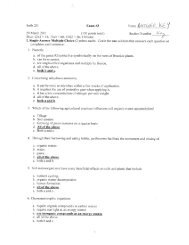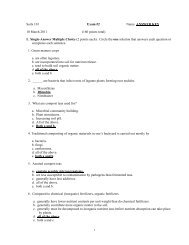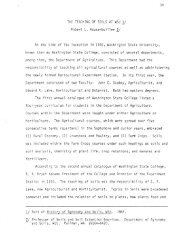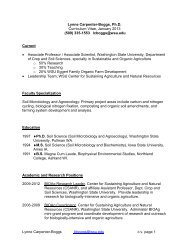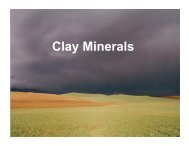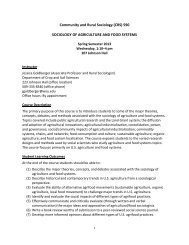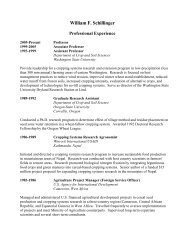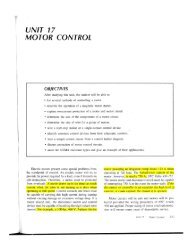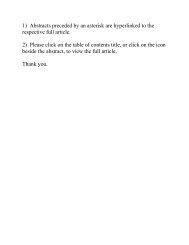2012 Dryland Field Day Abstracts - Dept. of Crop and Soil Sciences ...
2012 Dryland Field Day Abstracts - Dept. of Crop and Soil Sciences ...
2012 Dryland Field Day Abstracts - Dept. of Crop and Soil Sciences ...
Create successful ePaper yourself
Turn your PDF publications into a flip-book with our unique Google optimized e-Paper software.
Part 3. Agronomy, Economics, <strong>and</strong> Sustainability Page 49<br />
Heaven Hills is approximately 7500 acres, with half in winter wheat <strong>and</strong> half in summer fallow. Given that a farmer can cover<br />
about 160 acres per day with a primary tillage implement, it takes approximately 24 days to complete primary spring tillage. If<br />
the farmer waits until mid June to begin primary spring tillage, substantial evaporative soil loss may occur on non-tilled ground<br />
by mid July.<br />
Data from our study also suggest that farmers in the extreme dry western region <strong>of</strong> the Horse Heaven Hills should practice NTF in<br />
all but very wet years as they rarely have adequate seed-zone water for late-August planting, even with TF. The widespread<br />
practice <strong>of</strong> NTF would dramatically reduce wind erosion <strong>and</strong> likely save on operating costs compared to TF. In addition, farmers<br />
committed to practicing NTF in the long term could receive monetary payments from federal farm programs that reward<br />
environmental stewardship.<br />
Residue Protects Emerging Winter Wheat Seedlings from Rain-Induced <strong>Soil</strong> Crusting<br />
W.F. Schillinger, T.A. Smith, <strong>and</strong> S.E. Sch<strong>of</strong>stoll; <strong>Dept</strong>. <strong>of</strong> <strong>Crop</strong> <strong>and</strong> <strong>Soil</strong> <strong>Sciences</strong>, WSU <strong>Dryl<strong>and</strong></strong> Research Station, Lind<br />
Farmers in the low-precipitation region <strong>of</strong> the Pacific Northwest practice a 2-year tillage-based winter wheat- summer fallow<br />
rotation. Winter wheat is planted deep into moisture in late August or early September <strong>and</strong> seedlings emerge through 4 to 6<br />
inches <strong>of</strong> dry soil cover. Rain showers that occur after planting create fragile soil crusts that the emerging first leaf <strong>of</strong>ten cannot<br />
penetrate. A rainfall simulator was used to conduct a 5<br />
-factor factorial laboratory experiment to evaluate<br />
emergence <strong>of</strong> WW planted deep in pots. Factors were:<br />
(i) rainfall intensity <strong>and</strong> duration (0.05 inch per for 3<br />
hours, <strong>and</strong> 0.10 inch per hour for 2 hours); (ii) timing <strong>of</strong><br />
rainfall after planting (1, 3, <strong>and</strong> 5 days after planting +<br />
controls); (iii) variety (st<strong>and</strong>ard-height vs. semi-dwarf),<br />
(iv) residue on the soil surface (0, 750, <strong>and</strong> 1500 lbs/<br />
acre); <strong>and</strong> v) air temperature (70 0 <strong>and</strong> 86 0 F). The highintensity<br />
rain caused a 2.3-fold reduction in emergence<br />
compared to the low-intensity rain. Emergence<br />
improved proportionally with increasing quantities <strong>of</strong><br />
surface residue (Fig. 1). The st<strong>and</strong>ard-height cultivar<br />
had four times greater emergence than the semi-<br />
dwarf. Air temperature <strong>and</strong> timing <strong>of</strong> rainfall had no<br />
significant effect on WW emergence. Results show<br />
that planting a WW cultivar with long coleoptile <strong>and</strong><br />
first leaf as well as maintaining high quantities <strong>of</strong><br />
surface residue to intercept rain drops will enhance<br />
WW st<strong>and</strong> establishment after rain showers to benefit<br />
both farmers <strong>and</strong> the environment.<br />
No-till Summer Fallow is a Good Fit in the Western Horse Heaven Hills<br />
Fig 1. Percent emergence <strong>of</strong> Eltan <strong>and</strong> Buchanan winter wheat varieties<br />
planted deep into pots as affected by rainfall intensity <strong>and</strong> duration,<br />
residue cover, timing <strong>of</strong> rainfall, <strong>and</strong> heat. Data are the average<br />
from three runs. Data are combined for the two varieties. DAP =<br />
days after planting<br />
Bill Schillinger 1 , Tim Smith 1 , Steve Sch<strong>of</strong>stoll 1 , John Jacobsen 1 , Mike Nichols 2 , David Pearson 2 , Brenton Sharratt 3 , <strong>and</strong><br />
Markus Flury 1 ; 1 <strong>Dept</strong>. <strong>of</strong> <strong>Crop</strong> <strong>and</strong> <strong>Soil</strong> <strong>Sciences</strong>, WSU; 2 Horse Heaven wheat growers; 3 USDA-ARS, Pullman<br />
Blowing dust from excessively tilled summer-fallowed fields in the Horse Heaven Hills (HHH) is a major air quality concern in the<br />
Tri-cities, Washington. We conduct a 5-year on-farm field experiment at two HHH sites to determine the effects <strong>of</strong> no-till summer<br />
fallow, conservation tillage summer fallow, <strong>and</strong> traditional tillage summer fallow on: i) seed-zone moisture in late August, ii)<br />
wheat plant establishment, iii) wheat grain yield, <strong>and</strong> iv) dust emissions.<br />
Beginning in March 2006, replicated experiments were established on the David Pearson <strong>and</strong> Mike Nichols farms. The Pearson




